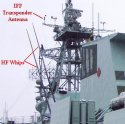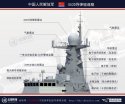This type of arrangement is "common" for single-face arrays, and is unnecessary for 4-panel arrays. Note that single-face fixed or rotating arrays are the ONLY examples you have provided thus far with an aligned IFF, which as I said makes total sense from a practical point of view.
Oh? These arrays also change direction.
Never showed any rotating IFF and there is none that exist that looks like a navigation radar.
The kind of arrangement used for four panel arrays with Western ships are ringed type. It does not turn around. With a ringed type IFF, there are always a panel turned directly towards a target.

Yeah, man, I see the IFF there. What I don't see is that thing on top of any PLAN version of the radar. LOL This once again leaves your universe with absolutely NOTHING in terms of IFF for the 054A, 051B, 052B, and 052C.
There is no such thing as rotary IFF that looks like a navigation radar. Go ahead and find a Western or Russian one the Chinese would find as its inspiration or model to ape from.
You also just provided an example of a dual-face rotating array (Tombstone) which CLEARLY does NOT have the IFF aligned with the main radar. I would not have posted that particular photo if I were you.

Wrong ID. That's Top Plate. You certainly don't know your radars. Tombstone is the FCR used for the S-300 complex. That is so totally in a different category. Given that Top Plate rotates, the IFF array will be directly on square with the target at one point in time. The perception that the array is offset is due to the main arrays being arranged a little offset.
Top Plate is the main search radars found on the 052B, 051C and 054A.
Nice try, but no. You're reaching for the stars here but falling far short. There's no bar anywhere in the back that could even remotely pass for an IFF. [/quote]

You don't seem to be familiar what High Pole is.
It is the mast on the back of the radar.

There are masts like that in those ships you mentioned. Guess what, they are far more likely to copy a Russian IFF system that exists than a non existent Western rotary IFF.
Oh and
APX-72 IFF transponder.


I told you that not all IFF look like bars.
Yeah, the PLAN. You provided a totally irrelevant photo of a Tombstone that does not have anything matching it within the PLAN, that in addition is a self-goal due to the non-aligned IFF which I'll bet is probably either fixed in position or rotating independently of the Tombstone, and would be an example of a navy with rotating IFF besides the PLAN.
What photo of Tombstone? I showed a picture of HT233 --- IFF mounted on top of the array, and MPQ-53, IFF mounted on the bottom of the array. Tombstone also has a subarray on top of the octagonal main array, and its likely to be IFF. The model for those is the Type 346 radar itself. They partly derive their naval systems from land systems, much like the Russians.
Plus once again, you don't know what Tombstone is. The picture I brought was Top Plate, and its used by the PLAN, along with its copy.
Unfortunately you and I both know that "Chinese documentation" is frequently non-existent wrt to both hardware and software systems on board its ships, so the astute watcher is left to figure out things on his own, in this case by process of elimination.
Damn, so you can't prove rotary IFF either. I am asking for
Western examples if you don't mind.
As for the alleged blockage, that is total hogwash. Unless you don't have mental facilities to picture the geometries in your head, a single rotating radar covers almost an entire 360 degrees, somewhere on the order of 300+ degrees, so 2 radars is more than enough coverage. Not only that, that is only visual line of sight. Radar actually bends so that radar horizons are greater than visual horizons, which means that mast may not even pose any kind of obstruction at all. In fact you essentially never see double coverage for navigation radars since there are usually only two of them on larger ships, as I said one in X-band and one in S-band. I guess for you the other 2 'navigation radars' are for redundancy in case the others break down? LOL
Umm. The arc towards the mast would have significant interference, and in particularly so with high frequency radars. What I see is one or two X-band radars, and two S or C band radars. Where their arcs meet, they can also double to quadruple the tracking update time of the target.
Having multiple navigation + weather radars isn't uncommon.

LOLOLOLOL exactly how long did it take you to find this laughably erroneous fan CGI while managing to miss all the real photos of real 052Ds??? Did you even bother to look at the real thing and check to see if there actually were any rotating Y-shaped rotating bars on REAL 052D photos? Come back with a real photo of this (if you would like to embark on a fool's errand). In the meantime, answer me which bands the FOUR navigation radars would be in. I already suggested X, Y, Z, and Sirius. Maybe you can correct me.

Actually I have never see any Chinese commenting the Y shaped rotary IFF as IFF.
Even if there is rotary IFF, it would always present a face directly on the target at one moment in time.
Show me a Western or Russian rotating IFF that the Chinese could copy.
LOL do you even understand what a straw man attack is? In just this conversation alone I have pointed out 2 intellectually dishonest instances of you employing straw man attacks against me, while this example you have cited here clearly shows you must have no idea what a straw man attack actually means. Lack of understanding the term does not seem to have prevented you from committing them nonetheless, however.
Really. I think you are just paranoid. Correcting you does not constitute an attack against you. In the meantime you are constantly berating other posters. It should be more than high time the moderators need to examine your actions.
In the meantime you use 'size' as the reason why one thing should be an IFF because its similar to the size of another, without any actual measurement. Then you go around saying this other thing is an IFF despite it does not have the same size at all with the other.
I showed you pictures of the Shandong with the long IFF bars on top of the Type 346 arrays, and along with the 052D having their IFF arrays on top of its Type 346 arrays, that the bars on the Type 055's main arrays should be IFF. That should be the default argument, and its up to you to provide the direct and extraordinary evidence that it is not.
















